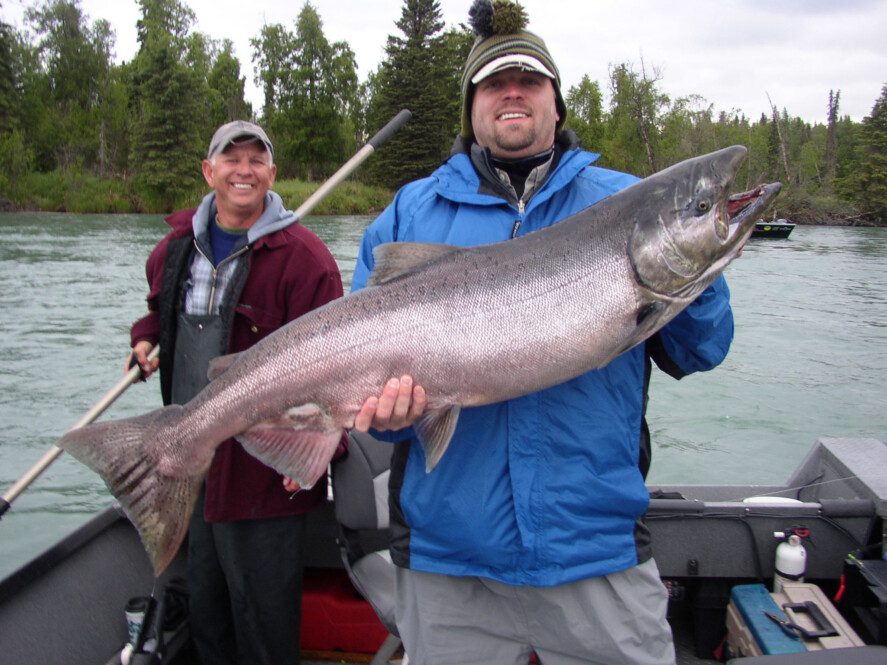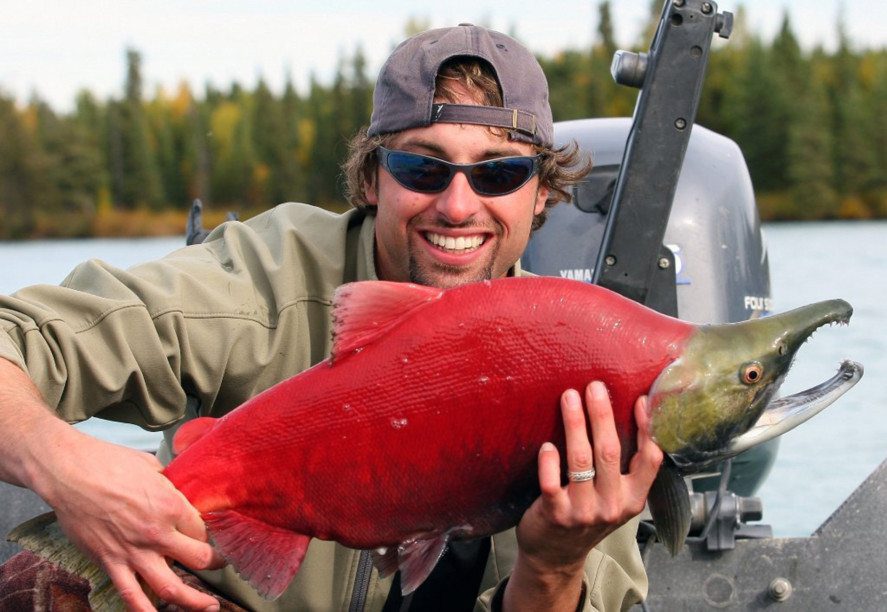Header photo courtesy of Ashley Heimbigner/Visit Anchorage
For visitors and residents alike, a special part of Alaska’s lure are the fantastic fish which thrive in the state’s waters. Diners and anglers are always delighted when they savor the taste of fresh Alaska salmon, Dolly Varden, halibut or Arctic grayling, “pole-to-plate,” artfully presented, whether at home or in one of Alaska’s many restaurants that make fish the focus of the dish.
When it comes to sports fishing in Alaska and the state’s finest fish, Alaska salmon is the star attraction.
There are five popular Pacific Salmon species that populate Alaska’s wild waters. These five Alaska salmon species have been sometimes referred to here as the “Fin-tastic Five.” Each of these salmon has its own unique physique and fins, fight and flavor profile, which varies based on fat content, the waters it travels in, the food it eats, and even how it was caught and processed, among many other factors. Heck, it’s practically an annual Alaska holiday when the first Copper River salmon is picked from a commercial fisherman’s net near Cordova and quickly transported on ice to Seattle via Alaska Airlines, where it kicks off salmon season and becomes the prized and high-priced “Catch of the Day” for Northwest restaurateurs and diners.

A guided Alaska fishing trip might get you a nice king salmon too!
#1: King Salmon: Alaska’s Marine Monarch
Many believe that Alaska’s King Salmon or Chinook salmon to be, well, the state’s “Marine Monarch,” and that’s true to a great extent. Alaska’s King Salmon is the official state fish, after all, and its lore of being a hard-pulling, great-tasting behemoth is no fishing tale. The story of Les Anderson certainly adds to the legend:
In 1985, Anderson reeled in the world record king caught with traditional tackle, weighing 97 pounds, 4 ounces, on the Kenai River. It’s a fishing feat so noteworthy, it landed Anderson in the Alaska Sports Hall of Fame. (The 126-pound Alaska king pulled from a fish trap near Petersburg in 1949 is recognized as the world’s largest caught king, though not caught by rod and reel a fisherman like Anderson.)
Even an average king salmon is regal, coming in at around three feet long and 20-plus pounds, and can be found on many of Alaska’s major waterways, especially the mighty Yukon River. It’s also known for its hooked nose/upper jaw and dark markings along its shiny silver body – black dots on its tail, dorsal fins, back and even mouth. And yeah, the king’s a delicious fish and its pretty bright orange meat make it a mainstay menu item in Alaska homes and restaurants, and around the world. And if you’re eating sushi in Alaska, ask for some White King sashimi – it’s rarely available, but those who do get a delicate bite will never forget it.
#2: Sockeye Salmon: A Decadent (and Delicious) Alaskan Flavor
The King Salmon might be Alaska’s pound-for-pound champ, but when it comes to in-demand deliciousness, no salmon tops the Sockeye or Red Salmon. They might be small among the salmon species (an average red is around two feet long and six pounds), but they are big-time battlers, making them popular among sport fishermen looking for top sport angling action. These smallish salmon are therefore a really big deal for Alaska. The sockeye is the most economically important of Alaska’s salmon thanks to its healthy and consistent runs and its high-quality taste. Reds are beloved and shipped around the world, fresh, frozen, smoked or canned. The best way to enjoy a red is to reel one in (or find one at a local market) and run to the grill! Or stroll into an Alaska-based restaurant that just received some of the fresh fish from the Bristol Bay region, then run to have a seat and place your order. Once prepared, it’s a special treat, its deep red flesh producing its distinctly decadent fatty flavor.

Catch a sockeye and YOU’LL be hooked!
#3: Coho (Silver) Salmon: Fish ON!
The Coho or Silver Salmon are often King Salmon lookalikes, with a few physical differences, the most obvious being its smaller stature: silvers average about 8-10 pounds and around 24 inches. Oh, and of course its sparkling bright silver scales that shimmer when they swim in salt water and upon their return to fresh water areas, where they begin turning red. Their body type and mild meat makes silver salmon fillets nearly perfectly serving sizes and highly sought-after for amateur and pro cooks. Once in Alaska’s fresh water, silvers can be found seemingly everywhere, from major rivers to small streams to even lakes. This accessibility, and their furious fighting spirit, make silvers a very popular sport fish. Bold fishermen, especially those who fly fish in Alaska, can often find themselves in for a thrilling 12-round tussle when a sturdy silver lands on the lure.
#4: Pink Salmon: Otherwise Known as “Humpys”
Care to take a guess at why Pink Salmon are also known as Humpys? Yep, it’s the big hump that males develop along their backs when they return to fresh water to spawn. Bonus round: They are also known as pinks due to their pinkish flesh. Humpys hold the distinction of being the smallest of the Pacific Salmon species, most often weighing around 3-5 pounds. But that doesn’t mean they aren’t ornery. Those humpbacked males vigorously prowl for eggs to spawn and occasionally even attack one another with their vicious teeth. Humans enjoy taking a bite out of them, too – they are caught in big numbers by commercial fishermen and make for great eats when fresh, canned or smoked. (Pink salmon meat is known to turn soft if frozen and thawed.)

Catch a wild Alaska salmon on a guided fishing trip.
#5: Dog Salmon: “Chum” or Keta Salmon
Many are quick to dismiss the fifth Alaska salmon species, and their names don’t exactly improve their reputation: Dog Salmon, Chum or Keta Salmon. They also are the most “interesting” looking salmon, turning from a sleek silver when swimming in the Pacific to a funky rainbow range of coloring (red, purple, green, brown, yellow), often appearing in stripes or streaks, when they return to spawn in Alaska’s freshwater. Their large, sharp teeth are also a bit intimidating. Their meat is firm and mild, which makes their market value lower than the other salmon species. It’s no wonder they’re marketed in some areas with the more fish-fan-friendly names “Silverbrite” or “Calico” salmon. So, what’s to like? They are a brawny and brawling fish, averaging from 7-15 pounds, and they also cover more range of Alaska’s waterways than any other Pacific Salmon, so they are easier to find for anglers across the state. Because there are so many chum in so many places, they are popular with subsistence fishers and families, who often smoke the meat to preserve them for entire winters. And when done right, smoked salmon is a delicious treat, even if the fish has a funny name.
Yearning for an Alaska fishing trip in 2022 or 2023? Find out what it’s like to catch your own Alaska salmon with a stay at an Alaska fishing lodge!
